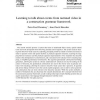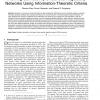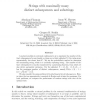1018 search results - page 158 / 204 » Generative unbinding of names |
AI
2005
Springer
13 years 9 months ago
2005
Springer
The current research presents a system that learns to understand object names, spatial relation terms and event descriptions from observing narrated action sequences. The system e...
TCBB
2008
13 years 9 months ago
2008
Recently, the concept of mutual information has been proposed for inferring the structure of genetic regulatory networks from gene expression profiling. After analyzing the limitat...
BMCBI
2005
13 years 9 months ago
2005
Background: Assignment of function to new molecular sequence data is an essential step in genomics projects. The usual process involves similarity searches of a given sequence aga...
AEI
2002
13 years 9 months ago
2002
Functionality of artifacts as well as structure and behavior plays crucial roles in problem-solving such as design. This article discusses automatic identifications of functional s...
COMBINATORICS
2004
13 years 9 months ago
2004
A natural problem in extremal combinatorics is to maximize the number of distinct subsequences for any length-n string over a finite alphabet ; this value grows exponentially, but...



